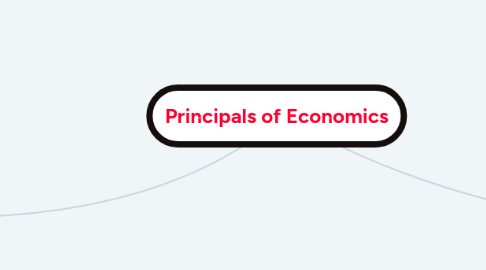
1. Chapter 2: Think like Economist.
1.1. Economists play two roles:
1.1.1. 1. Scientists: try to explain the world.
1.1.2. 2. Policy advisors: try to improve it.
1.2. As policy advisors, economists make normative statements, which attempt to prescribe how the world should be.
1.3. As scientists, economists make positive statements, which attempt to describe the world as it is.
1.4. The PPF illustrates the concepts of tradeoff and opportunity cost, efficiency and inefficiency, unemployment, and economic growth.
1.5. Microeconomics is the study of how households and firms make decisions and how they interact in markets.
1.6. Macroeconomics is the study of economy-wide phenomena, including inflation, unemployment, and economic growth.
1.7. The PPF could be a straight line, or bow-shaped depends on what happens to opportunity cost.
1.7.1. If opp. cost remains constant, PPF is a straight line.
1.7.2. If opp. cost of a good rises as the economy produces more of the good, PPF is bow-shaped.
1.8. The Production Possibilities Frontier (PPF): a graph that shows the combinations of two goods the economy can possibly produce given the available resources and the available technology.
1.9. Factors of production: the resources the economy uses to produce goods & services, including, labor, land, capital (buildings & machines used in production)
1.10. Model: a highly simplified representation of a more complicated reality. Economists use models to study economic issues.
1.11. The Circular-Flow Diagram: a visual model of the economy, shows how dollars flow through markets among households and firms
1.11.1. Two types of “actors”:
1.11.1.1. households
1.11.1.2. firms
1.11.2. Two markets:
1.11.2.1. the market for “factors of production”.
1.11.2.2. the market for goods and services.
2. Chapter 3: Interdependence and the Gains from Trade
2.1. Interdependence
2.1.1. Every day you rely on many people from around the world, most of whom you do not know, to provide you with the goods and services you enjoy.
2.1.2. One of the Ten Principles of Economics from Chapter 1: Trade can make everyone better off.
2.2. International Trade
2.2.1. Exports
2.2.1.1. goods produced domestically and sold abroad
2.2.2. Imports
2.2.2.1. goods produced abroad and sold domestically
2.3. These Gains Come From
2.3.1. Absolute advantage: the ability to produce a good using fewer inputs than another producer. If each country has an absolute advantage in one good and specializes in that good, then both countries can gain from trade.
2.3.2. Two countries can gain from trade when each specializes in the good it produces at lowest cost. Absolute advantage measures the cost of a good in terms of the inputs required to produce it.
2.3.2.1. Recall: Another measure of cost is opportunity cost.
2.4. Opportunity Cost and Comparative Advantage
2.4.1. Comparative advantage: the ability to produce a good at a lower opportunity cost than another producer
2.4.2. Differences in opportunity cost and comparative advantage create the gains from trade. When each country specializes in the good(s) in which it has a comparative advantage, total production in all countries is higher, the world’s “economic pie” is bigger, and all countries can gain from trade.The same applies to individual producers (like the farmer and the rancher) specializing in different goods and trading with each other.
